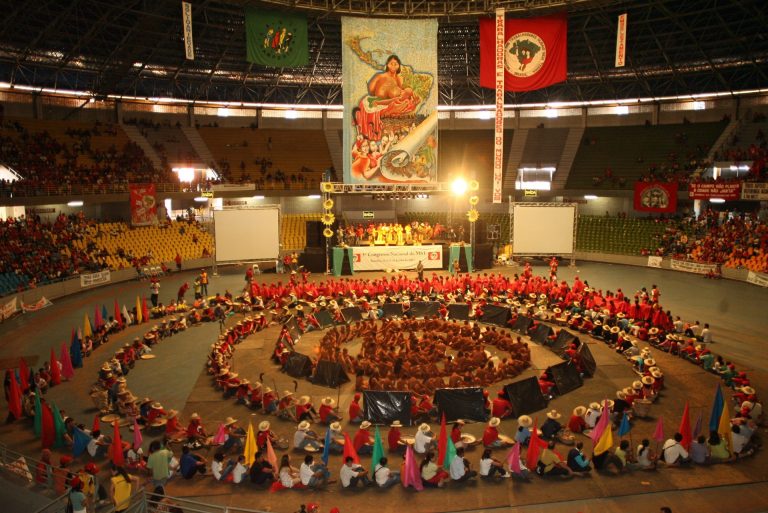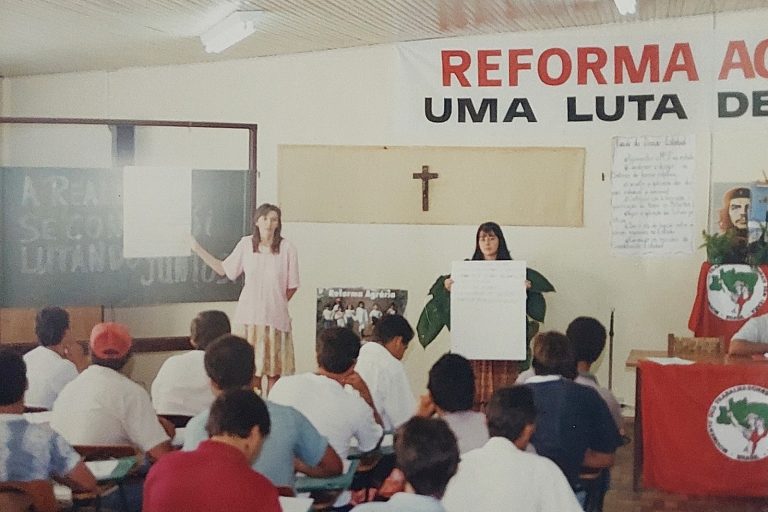Sem Terra Newspaper
The Sem Terra Newspaper: 40 years of popular communication strengthening the historic struggle of the MST
This Saturday (15/5), the Sem Terra Newspaper completed four decades of publication and circulation, as an instrument of popular and counter-hegemonic communication in the struggles and conquests of the MST in the country
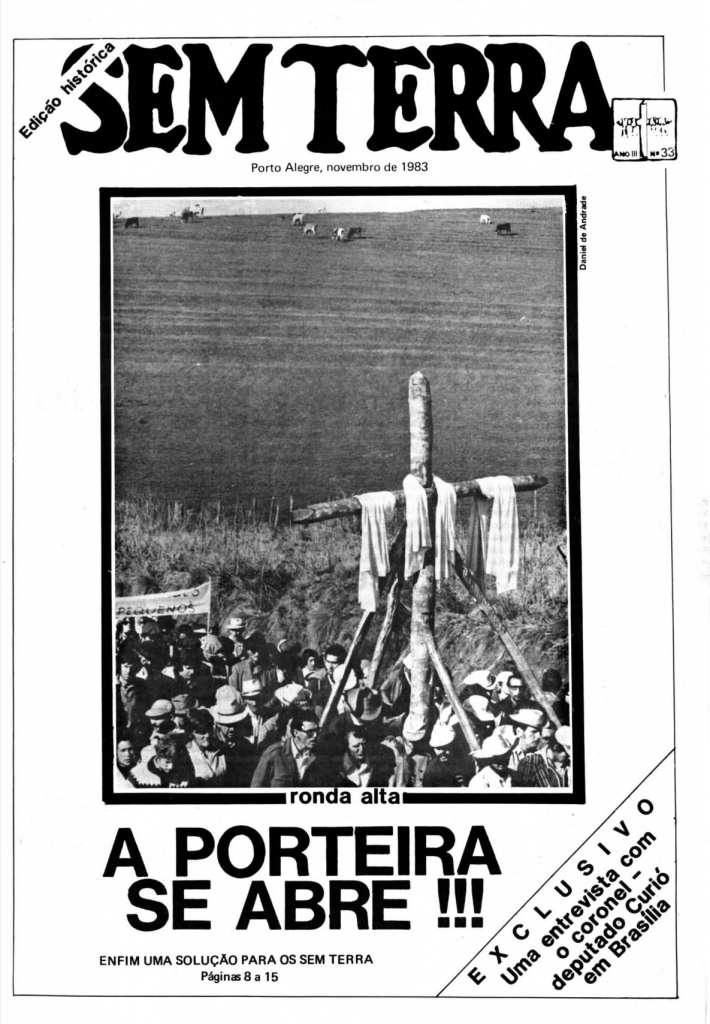
By Solange Engelmann
From the MST web-page
The period was one of intense struggles against the military dictatorship in Brazil (1964-1985), struggles also present in the countryside, with the repression by the regime against landless farmers in the South and other regions of the country, who organized themselves into peasant and farmer movements to fight for the land and for the right to remain in the rural areas, refusing to migrate to the cities.
In this context, three years before the founding of the MST, one of the Movement’s main and oldest means of popular communication was created, which would later become the organization’s newspaper: the Boletim Informativo da Campanha de Solidariedade aos Agricultores Sem Terra, first published on May 15, 1981, which would later be called Sem Terra Bulletin, and then Sem Terra Newspaper.
This Saturday (May 15), the Jornal Sem Terra (JST) comes of age. It has been 40 years of publication and circulation, accompanying the struggles and the historic resistance of the MST and the landless workers. It has been four decades working as an instrument of popular and counter-hegemonic communication in the social dissemination of information to the social base and to society about the struggles and achievements of the MST in the country, as well as about the agrarian situation and the repression against rural workers.
From Bulletin to Sem Terra Newspaper
The Sem Terra Bulletin appeared in the Encruzilhada Natalino encampment in the municipality of Ronda Alta, Rio Grande do Sul, in 1981, in view of the need for communication and dialogue between the encampment and society, in the search for support and resistance for the encamped families, who were suffering the repression of the military dictatorship.
“The Sem Terra Bulletin was born of the need for communication between the encampment and society. It was a belt that ran both ways, because initially it circulated among the organizations and friends of the encampment at that moment. This was the great goal that was to solve a problem, a communication problem”, says Maria Izabel Grein, from the MST state leadership in Paraná.
This is also reported by Salete Campigotto, who was camped in Encruzilhada Natalino and today coordinates the education sector in the Instituto Educar, in Pontão/RS, in the Área 9 settlement, former Anonni farm. “The first editions of this bulletin, which we now call Sem Terra Newspaper, were made by mimeograph. It was used as a means of communication in our encamped base, and was also distributed in the regions by the pastorals”.
Izabel explains that the edition of the Sem Terra Bulletin relied on a previous form of communication, which guaranteed the circulation of information from inside to outside of the encampment in RS, and vice versa. “The Sem Terra Newspaper began with the Sem Terra Bulletin, and the Sem Terra Bulletin began with the letters, which went from the encampment to Porto Alegre, where they reworked and it was a form of communication from the encampment to the outside, and also when they came back to bring news from outside to the encampment.”
Father Arnildo Fritzen, who accompanied the situation of the campers in Encruzilhada Natalino, northern region of Rio Grande do Sul, the space in which the MST took the first steps towards its foundation, emphasizes that the Landless Bulletin was an important communication instrument that arose, precisely in the struggles of the MST, mainly from the repression of the dictatorship, when it sent Colonel Curió to surround and repress the encamped families.
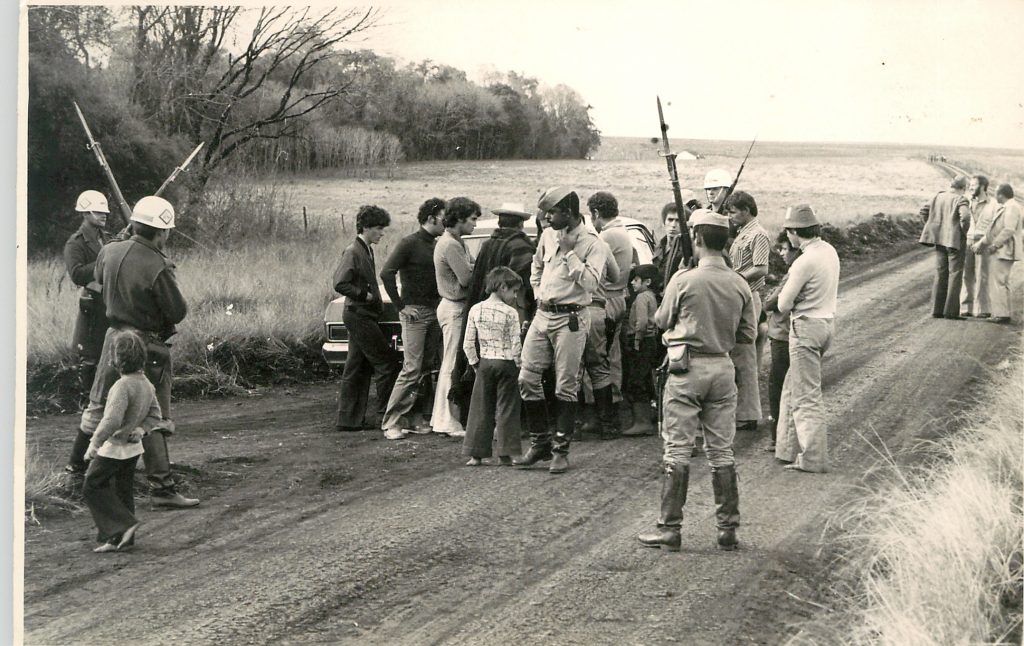
“In the Encruzilhada Natalino encampment we had a support group in Porto Alegre, with which we communicated and they spread the word in letters and in ways that they thought were best for their friends to know what was happening in the Encruzilhada Natalino encampment. And then we started to write about Natalino and send it to them, and they would publish it. That is when a bulletin was born, born exactly at the height of the struggle and, especially when Colonel Curió camped at Encruzilhada Natalino, we had more urgency to spread the news everyday. That’s where it was born, our beloved Sem Terra Newspaper.”
The history of the Sem Terra Newspaper is marked by phases, circulating for a period only in Rio Grande do Sul, then in the South, as the Sem Terra Bulletin and being produced in Porto Alegre/RS. At the 1st National Meeting of the Landless Rural Workers, in January, 1984, in Cascavel, Paraná, with the creation of the MST, there was also the decision to transform the bulletin into a tabloid newspaper with an initial circulation of 10 thousand copies. Thus, the Sem Terra Newspaper was created, aimed mainly at communicating with the grassroots base of the MST.
Its production and editing was transferred to São Paulo in 1985, a period in which the newspaper began to have national circulation. The following year, in 1986, the newspaper won the Vladimir Herzog Journalism Prize for distinguishing itself in the struggle for human rights and the democratization of communication.
The Importance of the Sem Terra Newspaper
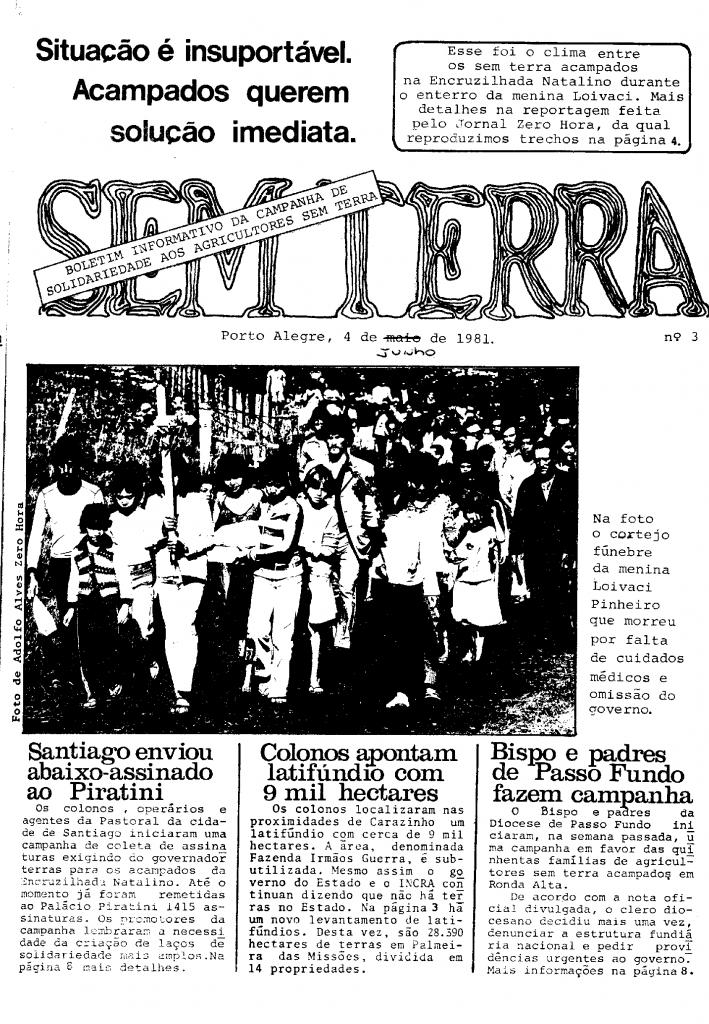
The history of the Sem Terra Newspaper (STN)is intertwined with the trajectory of the struggle of the MST and the Landless workers for Agrarian Reform in Brazil, for it is a popular means of communication that arose amidst the struggles of the Movement, and accompanies the process of struggle and resistance of the Landless, by informing, training, and mobilizing around the political strategies and actions of each period.
At the same time, the STN was also one of the main contributors to the construction of the identity of the Landless farmer movement, insofar as it made it possible for the Landless to learn about the struggles and actions carried out in the various states. In this sense, the STN plays a fundamental role as a means of information and political education between the Sem Terra base and society, as Maria Izabel reports.
“At the origins of the Landless Movement, the Sem Terra Newspaper fulfilled an extremely important task: it was a source of information, with news from all the states, a way for the militants to get to know the national movement. We would open the newspaper and there was news about what was happening, the occupations, the first settlements, if a school was built. Also on the front page there was always a conjuncture analysis. So, it was a study material that we used with the militancy in the meetings, in the preparation of the occupations, to understand how society was organized”.
At the same time, Izabel points out that, in the early years of the MST, the Sem Terra Newspaper not only informed, but also contributed to sustaining the organization’s militants. “At the end of 1984, 85, when the Landless were getting ready to make their first occupations, the militants who came to the meetings would bring a handful of newspapers to sell and to study. They sold these newspapers and used them as a source of income to travel, because the Movement had no money. It was also a source of income for militancy”.
The journalist and Master in Communication Sciences, Joana Tavares, who was part of the MST’s Communication Sector and worked on the edition of the Sem Terra Newspaper for a period, researched the formation of the STN in her Master’s dissertation, under the title: “From a Sem Terra Bulletin to a Sem Terra Newspaper: history, practices and its role in the constitution of the MST”, the intention being to analyze how the Bulletin contributed to the construction of the Movement, on a national scale. She argues, that what motivated the study was the strength and history of the newspaper.
“I was very impressed by the strength and history of the newspaper – looking at the date and seeing that it was so old, before the foundation of the MST itself, intrigued and delighted me. It was a story that caught my attention, how the Movement decided to support the newspaper and continued to invest in this tool for so many years. For me this is a very strong and symbolic example and a great learning experience.

Joana points out that the main results of the research indicated the importance of the MST having been concerned with creating a popular means of communication at the beginning of its struggle, to dialogue internally with the base and with society, friends and supporters.
“One of the conclusions is the intelligence that the Movement had in the beginning to worry about communication, both internally with its own base, who were in the encampments and had access to the content of solidarity letters that arrived, via the bulletin, which was also read out loud – one person I interviewed for the research said that it acted almost like a radio. And the concern to publish outside, with friends, with supporters of Agrarian Reform and to be a constant communication.”
The continued relevance of the Sem Terra newspaper
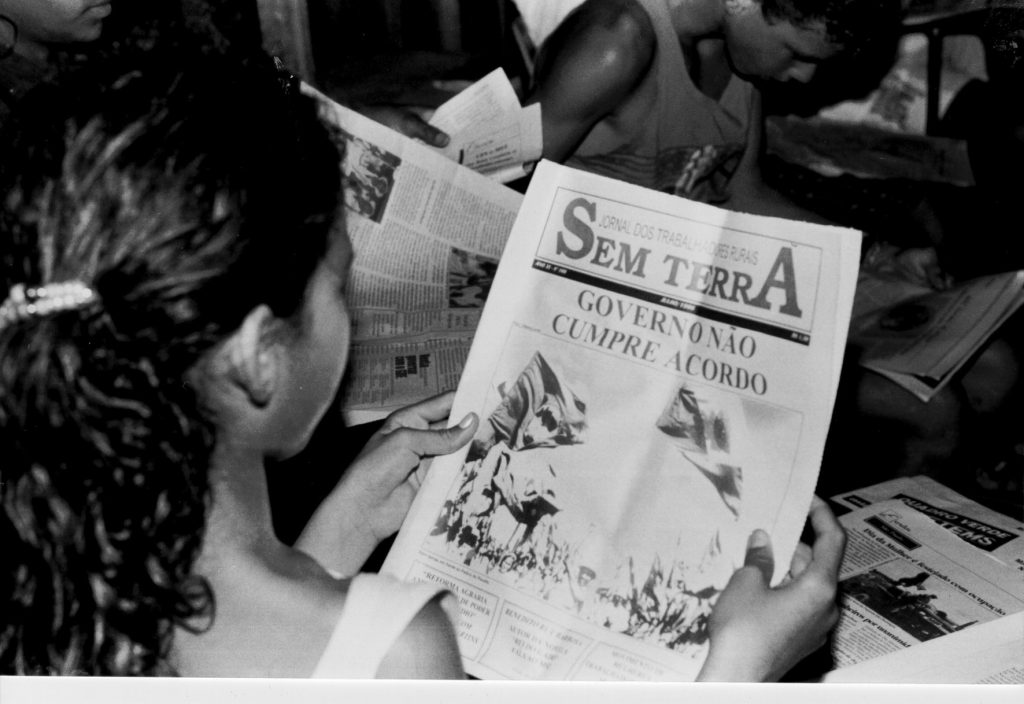
Since the creation of this instrument of communication, forty years ago, many things have changed in the struggle for land, in the MST and in communications, with the advance of the internet, the emergence of social networks and messaging applications, among others. Notwithstanding, the Sem Terra Newspaper remains an important instrument of communication, debate and mobilization of the landless workers in the struggle for the democratization of land and for Popular Agrarian Reform, as a historical heritage of the working class and of popular communication in Brazil.
Izabel and Joana emphasize the timeliness of the Sem Terra Newspaper, in the face of advances in digital media and other instruments of communication today. “We have many places where the internet doesn’t reach, with sufficient quality to be able to read something or watch a video. So, the physical newspaper would still be a tool that could fulfill this function. I think that the physical newspaper has another function that is different from the internet. And there are people who also have difficulties to read something on their cell phones. I think that the physical newspaper still has a function”, defends Izabel.
Joana considers that the internet and social networks do not replace the printed newspaper and believes in the potential of this medium, in relation to learning. “The newspaper brings a need for concentration, study, and reflection. I believe in the potential of the printed newspaper, because it leads to an exchange, which is much more powerful. Reading encourages writing, which is another wonderful thing that the Sem Terra Newspaper also has. I think this time, of writing and reading, is essential for the political struggle, for Agrarian Reform and for humanity itself”, she concludes.
Check out the virtual exhibition 40 years of Popular Communication: From the Bulletin to the Jornal Sem Terra!
*Edited by Fernanda Alcântara

